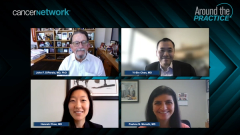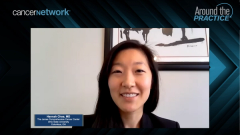
Clinical Scenario 2: Steroid-Refractory Chronic GVHD
Key opinion leaders in stem cell transplant and cellular immunotherapy review therapeutic considerations for the clinical scenario of a patient with steroid-refractory chronic GVHD.
Episodes in this series

Transcript:
John F. DiPersio, MD, PhD: I want to talk about another case here. A 71-year-old man presents, the same patient, and then progresses to the point now, this is the same story. You’ve treated him with steroids and then you’ve put him on RUX [ruxolitinib], and now they’re really getting bad, progressive muscle and joint pains, stiffness. This is not only steroid-refractory chronic GVHD [graft-vs-host disease] but may have failed your initial interventions. What are you thinking about at this point? What are other approaches besides ruxolitinib that you might think of?
Hannah Choe, MD: Belumosudil has been shown in the phase 2 trial to have response in patients who have failed ruxolitinib prior. It’s certainly an option. I think belumosudil is going through what ruxolitinib was going through when it was first FDA approved, which is delays in being able to start it because of insurance issues, and access and cost. Eventually, it might be a more readily available option. What we do at our center right now is for patients who are refractory to ruxolitinib, try to get them onto a clinical trial and at the same time evaluate what the cost to the patient would be to try to do belumosudil. If belumosudil is an option and a clinical trial is not, then we’ll obviously start belumosudil and monitor for tolerance and then have a low threshold to go to clinical trial for tolerance.
Yi-Bin Chen, MD: Can I add that I agree completely? I think the other issue with belumosudil is that we lack real-world data. All we have is the trials that were done in selected populations, and we don’t have summaries of real-world data and real-world experience. And then, the other thing is at least ruxolitinib had years of use or familiarity with the agent from myeloproliferative disease. That drove its use and its acceptance. It also works very well, so that helped, but I think that it remains to be seen. I think we’ll see a lot over the next year when we’ve been able to treat a fair number of patients with belumosudil to see what our enthusiasm is.
John F. DiPersio, MD, PhD: I want to say one other provocative thing as well. That is that in all of these trials, the major effect has been to reduce progression. There have been very few studies that show major responses, especially in the key organ systems, but it’s the time to progression that seems to be the main thing. What are the expectations for someone who has severe chronic GVHD who goes on a new medication? Should they expect to be completely better in a month and 2 months and 3 months? What do you all think?
Hannah Choe, MD: Unfortunately, no. The overall response rate is relatively high for these new agents, but the complete response [CR] rate remains very low, and complete response rate is in all organ systems involved, and so that might be asking too much with the current therapies. It’s something we’re hoping for in future clinical trials. For me, the biggest thing is how quickly can I get them on a lower dose of steroids? How much can I preserve of their functional capacity and their tolerance off steroids? If we’re at least able to stabilize or improve symptoms in a partial response, but I’m able to wean steroids more quickly, that’s certainly a win.
John F. DiPersio, MD, PhD: Pashna?
Pashna N. Munshi, MD: I think this might be just one situation where I would not agree with less is more, in the sense that yes, you want to come off steroids. But then, you also want to make sure you’re targeting multiple pathways once they’re in this chronic GvHD bubble with so many organ systems involved. Thus, you’ve got them on a bit of JAK1 and JAK2 inhibition. You’ve got them on a Rho kinase inhibitor. You probably want a bit of a calcineurin inhibitor, maybe you’ll go back to old school methotrexate, maybe you’ll try some photopheresis if the condition is skin only. I think to control it, you have that 1 shot in that little tincture of time paradigm, and so you may have to do a few more extra things in order to wean them off that steroid effectively.
John F. DiPersio, MD, PhD: Yes. Yi-Bin?
Yi-Bin Chen, MD: I think it illustrates that we need some better diagnostics here to understand what pathways are active in which patient. Most of our patients who are significantly affected do end up on multiple therapies. If you look at the trials today that have been mentioned and the end points that we’ve used, this overall response rate that we quote, but greater than 90% of those responses are all PRs [partial responses], right. There are very few CRs in this disease, and that may be inherent to the disease, that maybe we don’t have the right drugs. But it also may be that we just don’t understand what pathways are driving the disease itself. And thus, I think that we need more therapies and understanding how to use them, but really some precision medicine-based approach to be able to understand what therapies are best for which patient. I think if we had those tools, we would go a long way here.
John F. DiPersio, MD, PhD: I think the other thing about the one randomized trial that was done, the difference between the 2 groups was primarily in time to progression. That was the big difference. It wasn’t the CR rates or PR rates. It was the time to progression that was the major thing. Thus, I think patients need to have a reasonable expectation that we can probably make you a little better, but the main thing is that we don’t want this to get worse. And this is why we’re intervening.
Transcript edited for clarity.
Newsletter
Stay up to date on recent advances in the multidisciplinary approach to cancer.






















































































